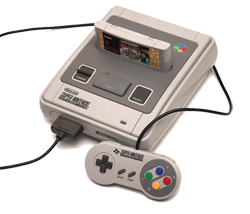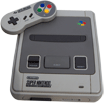Presentation :
The Super Nintendo Entertainment System (also known as the Super NES, SNES or Super Nintendo) is a 16-bit video game console developed by Nintendo that was released in 1990 in Japan, 1991 in North America, 1992 in Europe and Australasia (Oceania), and South America in 1993. In Japan, the system is called the Super Famicom, or SFC for short. In South Korea, it is known as the Super Comboy and was distributed by Hyundai Electronics. Although each version is essentially the same, several forms of regional lockout prevent the different versions from being compatible with one another.
The Super Nintendo Entertainment System is Nintendo's second home console, following the Nintendo Entertainment System (NES). The console introduced advanced graphics and sound capabilities compared with other consoles at the time. Additionally, development of a variety of enhancement chips (which were integrated on game circuit boards) helped to keep it competitive in the marketplace. While crude three-dimensional graphics had rarely been seen before on home consoles, utilizing the Super FX chip beginning with Star Fox in 1993, the SNES was able to run games with smoother and more detailed three-dimensional graphics than was previously possible. This sparked more widespread interest in polygon graphics in the industry, helping to usher in 3D graphics as seen in the fifth generation of video game consoles.
The SNES was a global success, becoming the best-selling console of the 16-bit era despite its relatively late start and the fierce competition it faced in North America and Europe from Sega's Genesis/Mega Drive console. The SNES remained popular well into the 32-bit era, and continues to be popular among fans, collectors, retro gamers, and emulation enthusiasts, some of whom are still making homebrew ROM images.


History :
To compete with the popular NES/Famicom, NEC launched the TurboGrafx-16 in 1987, and Sega followed suit with the Sega Genesis/Mega Drive in 1988. Both systems were built on 16-bit architectures and offered improved graphics and sound over the 8-bit NES. However, it took several years for Sega's system to become successful. Nintendo executives were in no rush to design a new system, but they reconsidered when they began to see their dominance in the market slipping.
Designed by Masayuki Uemura, the designer of the original Famicom, the Super Famicom was released in Japan on Wednesday, November 21, 1990 for ¥25,000 (US$210). It was an instant success; Nintendo's initial shipment of 300,000 units sold out within hours, and the resulting social disturbance led the Japanese government to ask video game manufacturers to schedule future console releases on weekends. The system's release also gained the attention of the Yakuza, leading to a decision to ship the devices at night to avoid robbery.
With the Super Famicom quickly outselling its chief rivals, Nintendo reasserted itself as the leader of the Japanese console market. Nintendo's success was partially due to its retention of most of its key third-party developers from its earlier system, including Capcom, Konami, Tecmo, Square, Koei, and Enix.
"Nintendo's strongest selling point, however, was the game that came packed in with the Super NES console—Super Mario World."
On August 23, 1991, Nintendo released the Super Nintendo Entertainment System, a redesigned version of the Super Famicom, in North America for US$199. The SNES was released in the United Kingdom and Ireland in April 1992 for GB£150, with a German release following a few weeks later. The PAL region versions of the console use the Japanese Super Famicom design, except for labeling and the length of the joypad leads. Both the NES and Super NES were released in Brazil in 1993 by Playtronic, a joint venture between the toy company Estrela and consumer electronics company Gradiente.
The Super NES and Super Famicom launched with only a few games, but these games were well received in the marketplace. In Japan, only two games were initially available: Super Mario World and F-Zero. In North America, Super Mario World shipped with the console, and other initial titles included F-Zero, Pilotwings (both of which demonstrated the console's "Mode 7" pseudo-3D rendering capability), SimCity, and Gradius III.


The rivalry between Nintendo and Sega resulted in one of the fiercest console wars in video game history, in which Sega positioned the Genesis as the "cool" console, with more mature titles aimed at older gamers, and edgy advertisements that occasionally attacked the competition. Nintendo however, scored an early PR coup by securing the first console conversion of Capcom's arcade classic Street Fighter II for Super NES, which took over a year to make the transition to Genesis. Despite the Genesis' head start, much larger library of games, and lower price point, the Genesis only controlled an estimated 60% of the American 16-bit console market in June 1992, and neither console could maintain a definitive lead for several years. Donkey Kong Country would pave the way for the Super NES to win the waning years of the 16-bit generation, and for a time, hold its own against the PlayStation and Saturn. According to Nintendo, the Super NES had sold more than 20 million units in the U.S. According to a 2004 study of NPD sales data, the Sega Genesis was able to maintain its lead over the Super NES in the American 16-bit console market.
During the NES era, Nintendo maintained exclusive control over titles released for the system—the company had to approve every game, each third-party developer could only release up to five games per year (but some third-parties got around this by using different names, for example Konami's "Ultra" brand), those games could not be released on another console within two years, and Nintendo was the exclusive manufacturer and supplier of NES cartridges. However, competition from Sega's console brought an end to this practice; in 1991, Acclaim began releasing games for both platforms, with most of Nintendo's other licensees following suit over the next several years; Capcom (which licensed some games to Sega instead of producing them directly) and Square were the most notable holdouts.
Nintendo of America also maintained a policy that, among other things, limited the amount of violence in the games on its systems. One game, Mortal Kombat, would challenge this policy. A surprise hit in arcades in 1992, Mortal Kombat features splashes of blood and finishing moves that often depict one character dismembering the other. Because the Sega Genesis version retained the gore while the SNES version did not, it outsold the SNES version by a ratio of three or four-to-one.
Game players were not the only ones to notice the violence in this game; US Senators Herb Kohl and Joe Lieberman convened a Congressional hearing on December 9, 1993 to investigate the marketing of violent video games to children. While Nintendo took the high ground with moderate success, the hearings led to the creation of the Interactive Digital Software Association and the Entertainment Software Rating Board, and the inclusion of ratings on all video games. With these ratings in place, Nintendo decided its censorship policies were no longer needed. Consequently, the uncensored SNES port of Mortal Kombat II became the preferred version among reviewers.
While other companies were moving on to 32-bit systems, Rare and Nintendo proved that the Super NES was still a strong contender in the market. In November 1994, Rare released Donkey Kong Country, a platform game featuring 3D models and textures pre-rendered on SGI workstations. With its detailed graphics, fluid animation and high-quality music, Donkey Kong Country rivaled the aesthetic quality of games that were being released on newer 32-bit CD-based consoles. In the last 45 days of 1994, the game sold 6.1 million units, making it the fastest-selling video game in history to that date. This game sent a message that early 32-bit systems had little to offer over the Super NES, and helped make way for the more advanced consoles on the horizon.
In October 1997, Nintendo released a redesigned model of the SNES (the SNS-101 model) in North America for US$99, which included the pack-in game Super Mario World 2: Yoshi's Island. Like the earlier redesign of the NES (the NES-101 model), the new model was slimmer and lighter than its predecessor, but it lacked S-Video and RGB output, and it was among the last major SNES-related releases in the region. A similarly redesigned Super Famicom Jr. was released in Japan at around the same time.
Nintendo ceased production of the SNES in 1999, about two years after releasing Kirby's Dream Land 3 (its last first-party game for the system) on November 27, 1997, a year after releasing Frogger (its last third-party game for the system). In Japan, Nintendo continued production of the Super Famicom until September 2003, and new games were produced until the year 2000, ending with the release of Metal Slader Glory Director's Cut on December 1, 2000.
Many popular SNES titles have since been ported to the Game Boy Advance, which has similar video capabilities. In 2005, Nintendo announced that SNES titles would be made available for download via the Wii's Virtual Console service. In 2007, Nintendo of Japan announced that it would no longer repair Family Computer or Super Famicom systems due to an increasing shortage of the necessary parts.
Technical Specification :
- Processor : 16 bits 65C816 clocked 3,58, 2,68, or 1,79 MHz
- RAM : 128 KB
- PPU (Picture Processing Unit) 16 bits
- Video RAM : 128 KB, 64 KB for texture and 64 KB for sprites
- Colors number : from 256 to 4096 on screen in 32768
- Resolution : from 256x224 to 512x448 pixels
- 4 scrolling plan
- Sprites number : 128, from 8x8 to 128x128 pixels
- Audio Processor: Sony SPC700 8 bits, S-SMP 16 bits 32 kHz, S-DSP 16 bits 32 kHz, 2a03 (65c816).
- Sound : 16 bits, 16 channels, ADPCM compression.
- S-SMP :musical synthesizer,
- 8 channel ADPCM 16 bits 32 kHz,
- S-DSP : Environement sound processor
- 3 channel ADPCM 16 bits 32 kHz
- 2A03 : PSG processor 5 channel
- 2 channel "square"
- 1 channel "triangle"
- 1 channel FM (delta PCM)
- S-SMP :musical synthesizer,
- Audio RAM : 64 KB
- Sound : 16 bits, 16 channels, ADPCM compression.







.webp)
.webp)